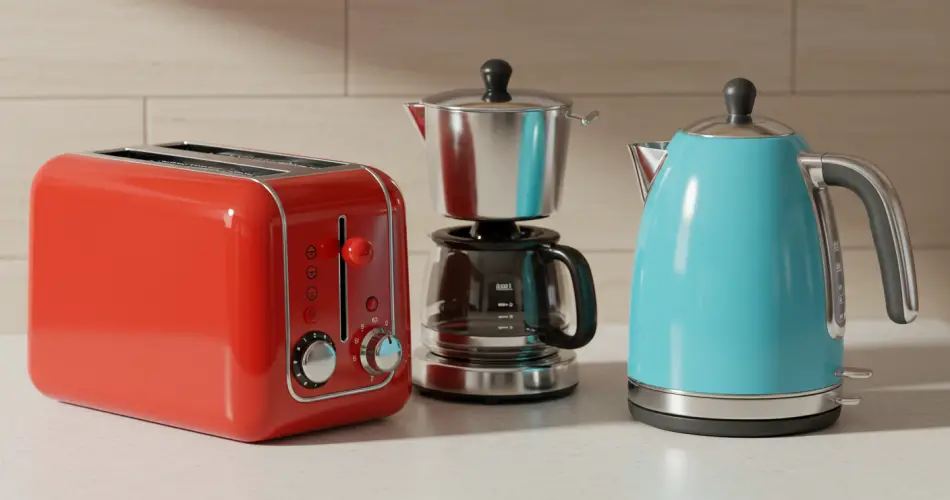In modern homes, electricity consumption is a growing concern, especially as energy bills continue to rise. Many people wonder which household appliances consume the most electricity and how to reduce overall energy usage without giving up comfort. Some devices are essential, particularly during certain seasons, but with smart usage, it’s possible to minimize their impact on your bills.
Tips to Save Energy at Home
Reducing electricity consumption is important not only for saving money but also for protecting the environment. There are several simple strategies that can help lower energy usage in the household:
-
Switch to LED bulbs – LED lighting is far more energy-efficient than traditional incandescent bulbs and has a significantly longer lifespan.
-
Turn off lights when not in use – Avoid leaving lights on in empty rooms.
-
Choose energy-efficient appliances – When purchasing appliances, always check their energy rating. Opt for models rated A+ or higher, as they consume considerably less electricity than older, less efficient devices.
-
Avoid placing hot food in the fridge – Allow food to cool before storing it. Putting hot items directly in the refrigerator forces the appliance to work harder, increasing energy consumption.
-
Use the washing machine efficiently – Run full loads only and, if possible, schedule washing cycles during off-peak hours when electricity costs are lower.
-
Switch off appliances completely – Do not rely solely on standby modes; televisions, computers, and other electronics consume energy even when not in active use.
By following these strategies, you can reduce household electricity usage and contribute to environmental sustainability.
Appliances That Consume the Most Electricity
Certain appliances are notorious for consuming high amounts of electricity. Knowing which devices have the biggest impact can help you use them more efficiently.
1. Electric Oven – The electric oven ranks seventh among high-energy-consuming appliances. It’s frequently used for cooking meals or baking desserts, which makes it a significant contributor to electricity bills. To reduce energy consumption:
-
Use the convection mode whenever possible, as it cooks food faster and more evenly.
-
Only turn on the oven when necessary and try to cook multiple dishes simultaneously to make the most of its capacity.
-
Opt for modern, energy-efficient oven models that maintain excellent performance without excessive power usage.
2. Dishwasher – The dishwasher comes in sixth place on the energy consumption list. Heating water and drying dishes requires considerable electricity. To save energy:
-
Use eco-friendly or low-temperature wash cycles.
-
Avoid overloading the dishwasher to ensure it cleans efficiently with less water and energy.
-
Open the dishwasher slightly before the end of the drying cycle to let dishes air-dry naturally.
3. Microwave – Surprisingly, the microwave ranks fifth in energy usage. Daily use can increase electricity bills by as much as €30 per year. To minimize consumption:
-
Choose a modern, energy-efficient model with automatic standby or A+++ rating.
-
Use the microwave only when necessary, and prefer batch heating over multiple small sessions.
High-Energy Appliances: Washing Machine, Refrigerator, and Hair Dryer
Some of the most commonly used household appliances, such as the washing machine, refrigerator, and hair dryer, also consume substantial electricity:
4. Washing Machine – Often perceived as a high-energy device, the washing machine actually ranks fourth. To save energy:
-
Wash full loads to maximize efficiency.
-
Use cold or low-temperature cycles whenever possible.
-
Run the machine during off-peak hours to reduce energy costs.
3. Refrigerator – The refrigerator operates continuously throughout the year and is crucial for food storage. Despite this, it occupies the third spot in electricity consumption rankings. Tips for efficiency include:
-
Keep the fridge well-organized to minimize the frequency of opening the door.
-
Ensure that seals are intact to prevent cold air leakage.
-
Maintain a reasonable internal temperature and avoid overcrowding the fridge.
2. Hair Dryer – Small but powerful, the hair dryer ranks second in household energy usage. Using it daily can significantly impact your electricity bills. Opt for newer models with lower wattage or efficient settings to reduce consumption.
The Appliance That Consumes the Most Electricity: Air Conditioner
Without a doubt, the air conditioner is the household appliance that consumes the most electricity, particularly during the summer months. This device continuously works to maintain a cool indoor temperature, counteracting high external heat levels.
How to Reduce Air Conditioner Energy Consumption:
-
Choose an energy-efficient model – Look for units with high energy ratings, which provide optimal cooling with less power consumption.
-
Regular maintenance – Clean or replace filters frequently and schedule professional checks to ensure the system operates efficiently.
-
Use the air conditioner only when necessary – Avoid leaving it on all day, especially when no one is home.
-
Complement with fans – Ceiling or portable fans can help distribute cool air, allowing you to cool only the rooms you occupy.
-
Set a reasonable temperature – Avoid extreme temperature settings, which force the appliance to consume more energy.
By implementing these practices, you can enjoy a comfortable indoor environment without excessive electricity costs.
Final Tips to Optimize Appliance Use
Maximizing energy efficiency doesn’t mean sacrificing comfort. Simple habits can make a big difference:
-
Always choose appliances with high energy ratings.
-
Use washing machines and dishwashers only with full loads.
-
Avoid frequent fridge door openings.
-
Maintain air conditioning and ventilation systems.
-
Use standby or sleep modes wisely to minimize unnecessary energy consumption.
Even small changes in behavior can significantly reduce electricity usage, lower monthly bills, and contribute to a greener, more sustainable home. Understanding which appliance consumes the most electricity—especially the air conditioner—allows households to plan smarter and make energy-conscious decisions.



